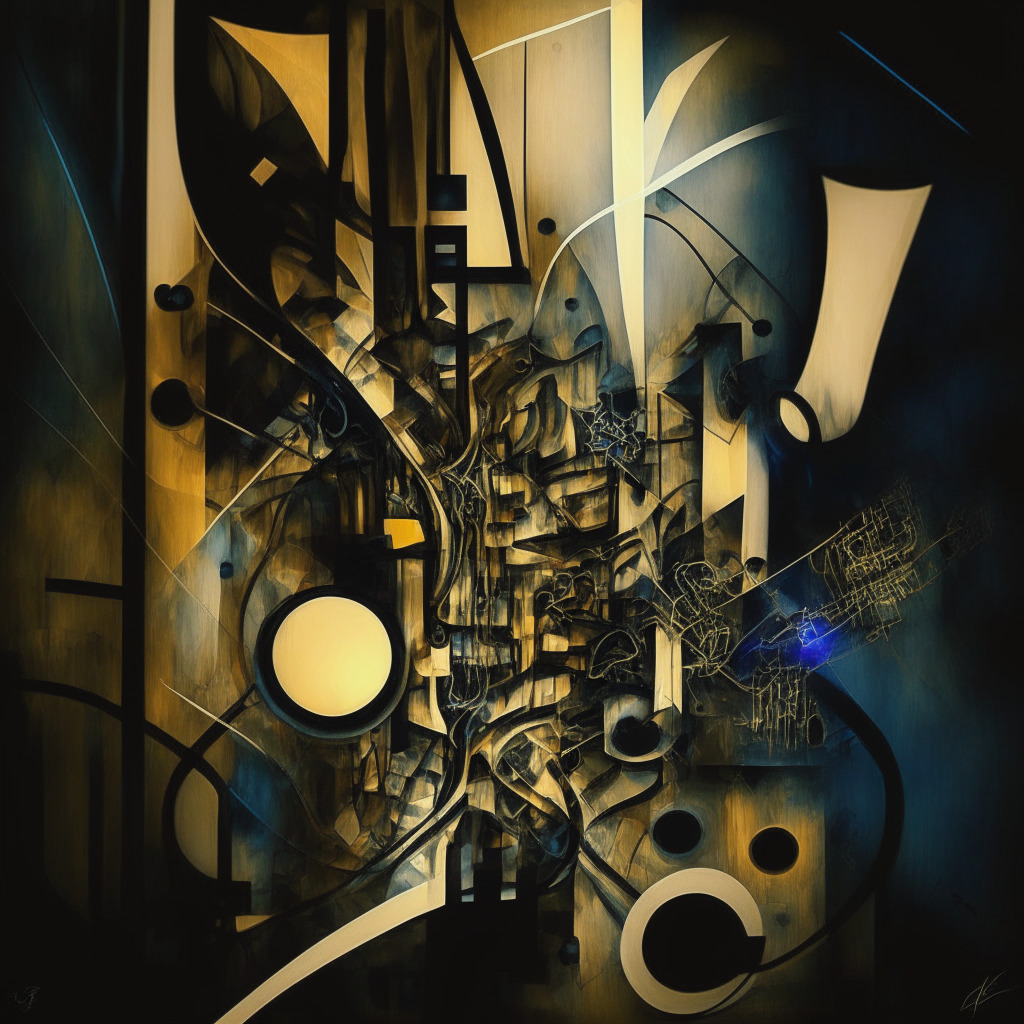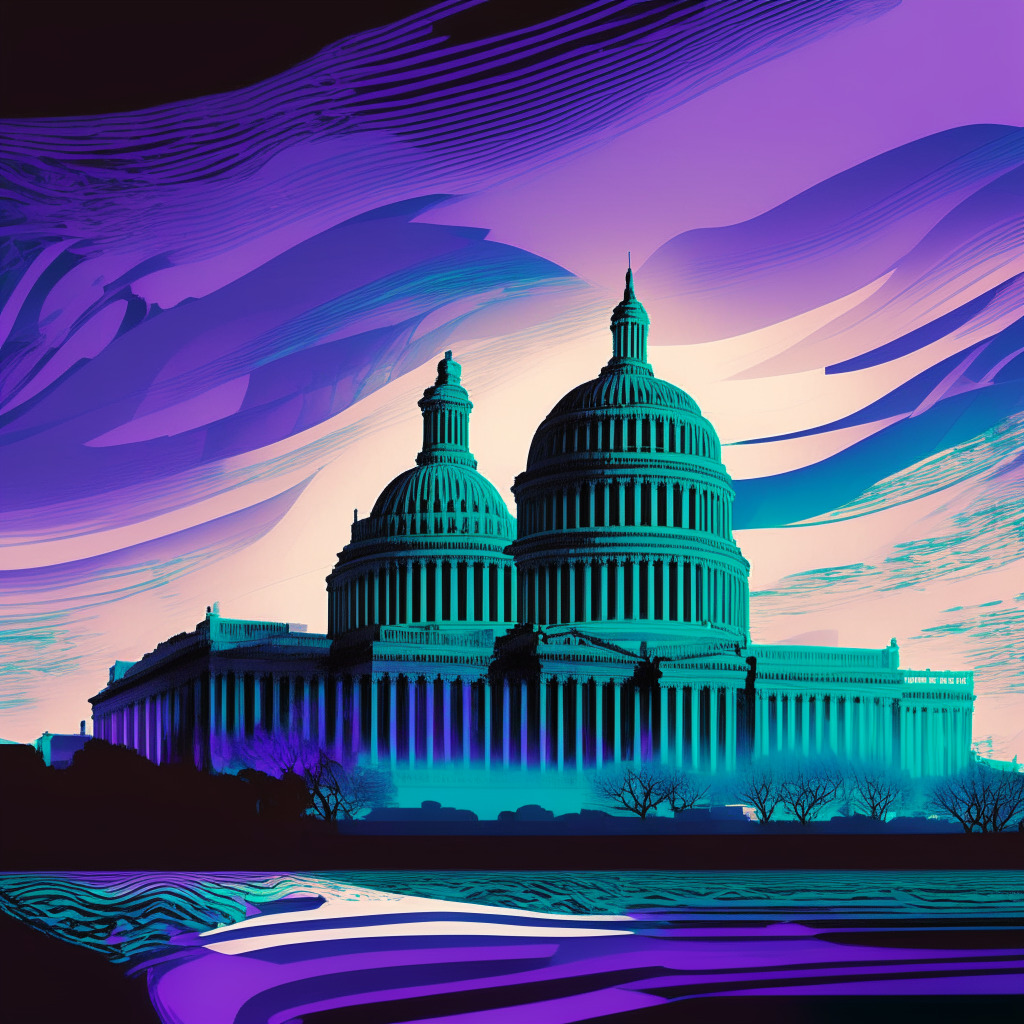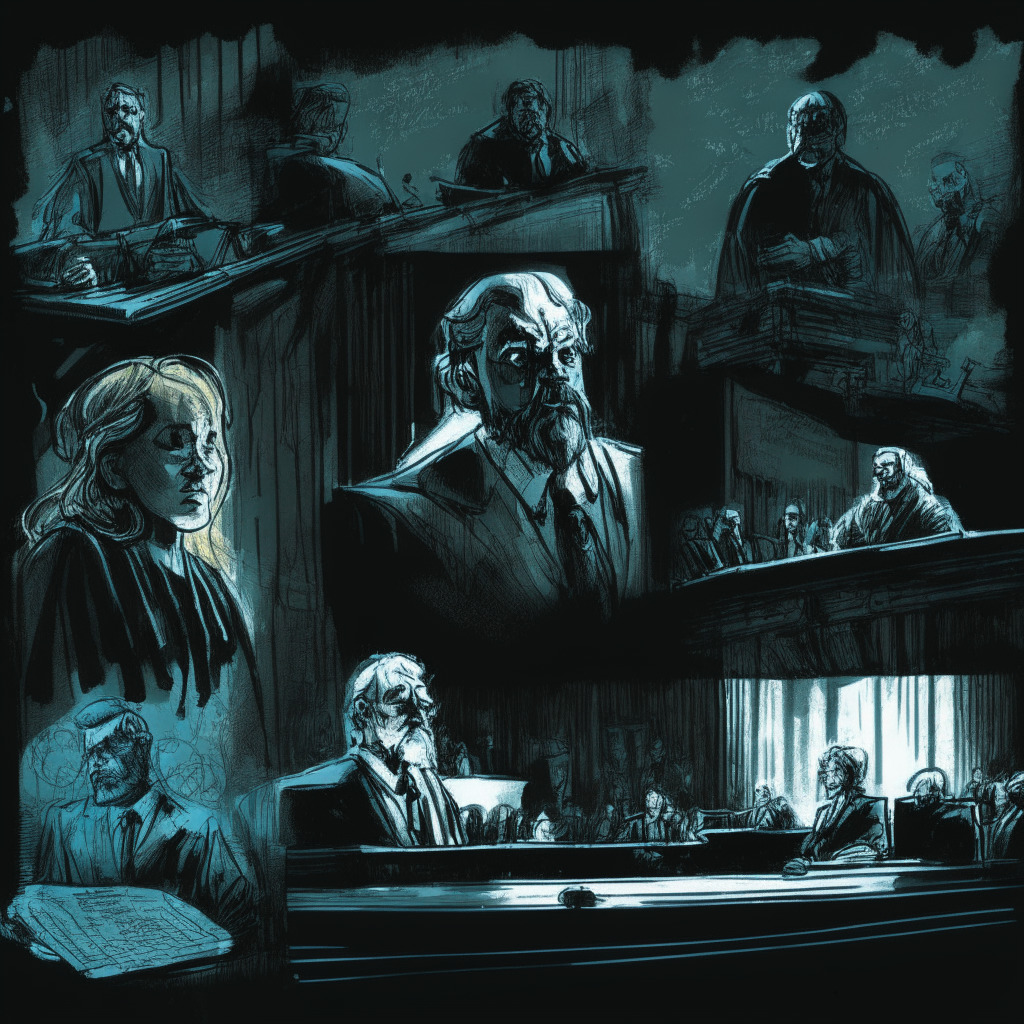“Roman Storm and Roman Semenov, coders of the Tornado Cash protocol, face U.S. legal proceedings, accused of aiding North Korea’s Lazarus Group with money laundering. This indictment raises questions on developer accountability, regulation standards, and the balance between potential national security risks and the right to financial independence and privacy in blockchain technology.”
Search Results for: maga
Navigating the Ethical Minefield of AI: Polite Bots, Deepfakes, and Job Security
“The proliferation of AI comes with both promises and perils. Increased AI interaction raises questions about our behavior towards technology and its impact on our human interactions. As AI’s capabilities expand, from solving CAPTCHAs faster than humans to possible misuse with deepfake technology, skepticism and scrutiny are crucial for a safe journey into an AI-powered future.”
The Legal Gambit of Crypto Mogul Sam Bankman-Fried: Blaming the Lawyers or Smart Defense Strategy?
Crypto figure Sam Bankman-Fried is facing legal charges including fraud, with a claim of acting in ‘good faith’ based on advice from his lawyers at Fenwick & West. This ‘advice of counsel’ approach could potentially disprove intent of fraud, but comes with risks like waiving lawyer-client confidentiality and unpredictability of having lawyers as witnesses. Adherence to the purported legal advice is key for this strategy’s success.
Binance’s SEPA Confusion: Miscommunication, Impact and Future Prospects in Europe
“Binance recently miscommunicated about the availability of euro transactions causing significant confusion. Amid troubled relations with regulatory bodies across Europe, such errors could impact Binance’s image and potential partnerships. CEO, Changpeng Zhao, urges users to ignore panic-inducing fears while awaiting transparent answers about Binance’s operations.”
AI-Generated Art: Pushing Boundaries or Distorting Authenticity?
“Botto, an AI creation, is redefining AI-generated art by learning and adapting to create new pieces that are evaluated through community votes and mintified as NFTs. However, the debate remains: can artwork encoded with emotion and symbolism be truly generated by AI?”
Blockchain vs Traditional Payments: A Detailed Analysis of Utility, Constraints and Potential
Cross-border payments demonstrate the utility of digital currencies, yet adoption faces challenges like technological issues, competition, and regulatory constraints. Blockchain Officer, Paul Brody, suggests basic fiat payments are faster and cheaper through centralized systems, while blockchain payments can impact speed and cost due to duplication across nodes. Blockchain’s potential may not lie in replacing existing models, but in altering the transaction rules through tokenization and inherent programmability.
Ran Neuner vs Ripple: Unraveling the Crypto Skepticism and Prospects for Future Market Evolution
Ran Neuner, Crypto Banter’s CEO, calls out Ripple for its centralized structure and the ethics surrounding the company’s conduct regarding its XRP token. His criticism extends to the practice of the centralized company selling tokens to support its own operations, a process he believes favors the company’s shareholders more than the token holders. Despite his harsh viewpoints, Neuner is also recognized for promoting an integrated approach to crypto, appreciating both centralization and decentralization, and advocating ethical, fair practices.
Unveiling the Crypto World’s New Star: Analyzing Friend.tech’s Promising Start and Potential Pitfalls
Friend.tech, a decentralized social media platform, is grabbing attention in the crypto community with about 64,500 unique addresses interacting in the initial two weeks. It generated $1.12 million in fees in 24 hours, also allowing users to buy “shares” in social media personas. However, concerns around privacy and longevity remain.
Rollercoaster Crypto Week: SEC Clashes, Price Tumbles, and Emerging Global Acceptance
This week in the crypto world saw a tumultuous phase as the SEC continues its litigation against Ripple Labs, while Bitcoin and Ethereum prices took a plunge. However, there are signs of hope as the EU welcomes its first Bitcoin ETF, and Coinbase gets regulatory approval for offering Bitcoin and Ethereum futures contracts.
Navigating Bitcoin Adoption in El Salvador: Opportunities and Challenges Unraveled
“During a trip to El Salvador, I saw innovative strategies to make Bitcoin more economically feasible, even for smaller investors. Key advancements like Lightning-enabled ATMs convert fiat to bitcoin with reduced costs, encouraging wider Bitcoin adoption. However, with Salvadoran banks’ legacy systems, non-bank services are crucial in facilitating digital currency acceptance.”
Untangling Asset Tokenization: Promising Innovation or a Risky Venture?
“Asset tokenization firm Securitize has acquired a digital asset wealth platform, Onramp Invest, intending to enable registered investment advisors to buy digital tokens. However, growing concerns around risk underscore the need for caution in the decentralised finance (DeFi) world.”
Crypto Community’s Internal Upheavals: Layoffs, Regulatory Confusion, and Billion-dollar Flash Crashes
“The cryptosphere is grappling with fundamental discords and minor tribulations. Beyond technical issues, it deals with the anxieties of those invested in it – its quintessentially human aspect. Amid all this chaos, we long for the simplicity amidst complex strife, mirroring crypto’s ambition to simplify finance while wrestling with its complexities.”
Navigating Uncharted Territory: A Comparative Analysis of Stablecoin Regulation Worldwide
“Recent news around CoinDesk and the temporary pause of their ‘Money Reimagined’ newsletter highlight the challenges faced by crypto media platforms. In this backdrop, a closer look at the regulatory landscapes shows varying global response to cryptocurrencies, notably stablecoins.”
Cryptocurrency in China: A Cat and Mouse Game of Capital Control and Legal Dilemmas
“Mr. Chen, a Chinese individual, was sentenced to nine months for aiding a $13,104 USDT transaction. Viewed as money laundering by authorities due to Chen’s personal bank information involvement, this reflects China’s stringent crypto stance linked to capital control regulations.”
Crypto Values in Mainstream Platforms: A Closer Look at Twitter’s Community Notes
“Community Notes, initially known as Birdwatch, offers users opportunities to appraise posts’ accuracy, emulating a digital governance form, reminiscent of Wikipedia but directed by an open-source algorithm. While this system aligns with ‘credible neutrality’ concepts from blockchain, its ability to provide an effective, unbiased truth filter remains uncertain.”
Exploring the Intersection of Gaming and Blockchain: Potentials, Challenges, and the Quest for a ‘Wow’ Moment
“In the convergence of blockchain and gaming, creating a ‘wow’ moment like ‘EVO Moment 37’ could trigger widespread interest and help crypto games gain a broader audience. Meanwhile, Layer-1 network Aelf is offering grants to studios to create blockchain games on their platform, predicting a substantial growth of the blockchain gaming market. Also driving change are games like Nitro Nation, which cleverly integrate NFTs in gameplay.”
The Ripple Effect of PayPal’s PYUSD: Potentially Forcing a Shift in Stablecoin Regulation Debate
The launch of PYUSD, a stablecoin backed by PayPal with over 430 million users, may accelerate crypto adoption and prompt a shift in U.S. policy towards crypto regulation. Despite previous hesitations, the massive user base might force lawmakers to urgently develop a comprehensive regulated framework for stablecoins, heralding a new era of American crypto companies demanding inclusion in economic life.
The Crypto Rollercoaster: Navigating Thrilling Highs, Crushing Lows and the Future of the Industry
“The ‘Greed & Fear’ index signifies a significant shift in the crypto sector, where recent Bitcoin resilience and optimistic judicial proceedings with the SEC indicate a promising future. Despite potential hurdles such as changing “custody rule” and the threat of quantum computers, Bitcoin’s technological prowess remains untouchable, fuelling innovation and unrestricted transactions.”
Redefining Use Cases: The Journey from Crypto Assets to Digital Renaissance
“Crypto progression mirrors how Web2 revolutionized informational accessibility. Decentralized finance (DeFi) pioneers a banking industry catered towards Web3, poised for a crucial paradigm shift. DAOs echo small businesses fostering economic activity, with Humans and AI unified through fintech networks, hinting a digital renaissance. However, challenges persist and must be addressed.”
Ransomware Attacks: The Ethical Dilemma of Paying Cyber Criminals in Cryptocurrency
“Ransomware presents an ethical quandary: fulfilment of ransom demand might restore operations quickly, but it also encourages more offences by funding future attacks. Banning ransom payments could push organizations to boost cybersecurity measures, but it might adversely impact victims. A combination of technology-driven solutions, policy measures and human alertness is needed to combat escalating cyber threats.”
Unleashing the Crypto Future: An Analysis of the FIT Act and its Impact on the Digital Asset Space
“The FIT Act marks the premiere of crypto-focused legislative efforts gaining traction in U.S. Congress. This signals mutual agreement about the significance of the digital assets sector, addressing the inadequacy of the current regulatory system, and fostering innovation. Policymakers are establishing a suitable framework for the rapidly evolving crypto industry.”
Coinbase’s Steadfast Endeavor: Future of Crypto Adoption Amid Regulatory Challenges
Coinbase, amidst falling trading volumes and revenue, is focusing on the future of crypto by launching a new blockchain. Key adoption aspects under discussion include blockchain scalability, non-financial crypto use utility, and navigating crypto regulation. The company advocates social solutions to resolve tech-related issues and is leading efforts to influence crypto-specific U.S. legislation through its nonprofit, Stand With Crypto.
Unraveling the NSA-Bitcoin Conspiracy: A Deep-Dive into Cryptocurrency Origins
“This article explores various theories surrounding Bitcoin’s origins, including a persistent one that Satoshi Nakamoto, the pseudonymous creator of Bitcoin, might be a covert NSA operation. The theory is based on Bitcoin’s use of the Secure Hash Algorithm 256, formulated by an NSA mathematician, and the agency’s 1996 paper introducing a Bitcoin-like system. However, counterarguments cite the organized methodology an intelligence agency would employ is inconsistent with Bitcoin’s development process.”
Unmasking Crypto’s Theatre of Absurd: Decentralization Illusion vs Real World Application
“Crypto appears to be an elaborate facade, with skepticism regarding the authenticity of use-cases. The recent market trends unveiled progress, while also revealing the failings of DeFi and Web3. Governance systems are under scrutiny, and real economic activity seems sidelined for speculation. However, a genuine decentralised future remains the goal.”
Crypto World Crucible: Regulatory Scrutiny, PayPal’s Stablecoin, and Lawsuit Shockwaves
“Last week in crypto: Bail of former FTX CEO revoked due to alleged witness intimidation, U.S. SEC delays Bitcoin ETF decision and plans Ripple Labs lawsuit appeal. PayPal reveals Ethereum-based stablecoin, but gains mixed market sentiments.”
Unraveling the Web of Deception Surrounding Crypto Mogul Bankman-Fried’s Legal Battle
“Sam Bankman-Fried, a renowned cryptocurrency figure, faces allegations of manipulating evidence and intimidating witnesses in a fraud case. Prosecutors suggest his untruthful narratives, attempts at tampering with witnesses, and use of VPN software to hide digital footprints could be misleading potential jurors and distorting the real story.”
Unleashing Stablecoins: Assessing PayPal’s PYUSD Launch Amid Political Divides and Regulatory Turbulence
“PayPal’s recent launch of its stablecoin, PYUSD, under the regulatory framework of the New York Department of Financial Services has stirred conversations about stablecoin adoption. Unlike Meta’s unsuccessful Libra, PayPal’s project is viewed more favorably politically, indicating an imminent regulatory framework for stablecoins in the U.S.”
NFTs and Art Collecting: Challenging the Conventional Paradigm with Mystery Artists
“Art collecting sees a shift with NFTs disrupting conventional paradigms and putting emphasis solely on art, not artists. Through blockchain technology, tokenized art is promoting unique speculative tendencies among collectors. Companies like Amazon Prime are also marking their entry into the NFT realm.”
Unlocking Trillions with Asset Tokenisation: A Balance of Potential and Risk
“This week in blockchain featured a focus on tokenisation of real-world assets, a promising industry potentially worth $5 trillion. However, concerns of standardisation in finance could hinder growth. Ralf Kubli, Casper Association board member, advocates for better quality and transparency of information in financial asset tokenisation to avoid replicating conditions that led to the Great Financial Crisis. “
Revolutionizing Finance: Blockchain and the Future of Asset Tokenization
“Blockchain technology has the potential to revolutionize financial assets trading by tokenizing real world assets. This process can enhance liquidity, reduce costs, and improve risk management. However, with the goal of benefiting economic growth and SMEs, a more standardized tokenization process must also accurately represent financial obligations, liabilities, and cash flows.”
Unveiling Apple’s New Gen AI: Bridging Innovation, Security and Ethics in the Tech World
“Apple is developing an in-house AI tool, aiming to enhance user experiences through AI integration in their forthcoming iOS17. However, this raises concerns over data security, prompting debate on whether AI should operate locally or on cloud. This has fueled greater focus on AI for mobile devices.”
Bridging Worlds: From Barbie Dolls to Blockchain Metaverse – A Comparative Analysis
“The foundation of experiential gateways like VR headsets isn’t technology, but the concept of transcending physical constraints. Our experiences within these gateways determine their true purpose. The metaverse takes on meaning through our communal engagement, not limited by its blockchain foundation.”































